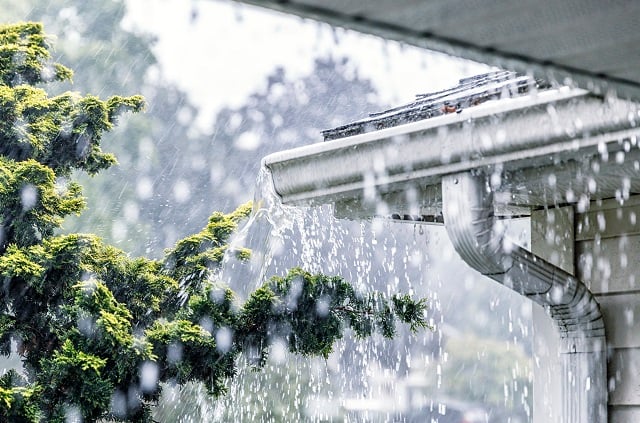 A home needs the correct design and architecture to route storm water away from it to prevent flooding and ensuing water damage. Roofing and gutter design are important elements that divert moisture to keep it away from your home’s foundation.
A home needs the correct design and architecture to route storm water away from it to prevent flooding and ensuing water damage. Roofing and gutter design are important elements that divert moisture to keep it away from your home’s foundation.
To prevent flooding and water damage, consider home improvement projects such as installing storm drain pipes that move rain water to a municipal storm water system. Installing a French drain system to collect water is another solution to consider.
History of Drainage Systems
The ability to drain away water has always been important in the construction of homes.
Ancient civilizations created drain systems that featured impressive and elaborate aqueducts. Older structures often featured drainage systems made from materials such as stone, wood, lead and clay.
Recent technological advances have enabled drainage systems to be manufactured with materials such as brass, copper, and some types of plastic.
Roofs Throughout Time
Roofs have always been a necessary architectural element to maintain shelter and keep the elements at bay.
- Thatched roofs made from grasses, reeds, or straw were an early innovation that kept the rain and sun away. After drying the vegetation, people layered it to keep moisture out.
- Wood shingles gradually replaced thatched roofs, and clay roofing tiles were another option.
- Roofing materials have continued to evolve, now including metal, bituminous materials and asphalt.
Since the beginning, roofs were designed with a slope to route rainwater away from structures. Water naturally flows down the sloped surface of any properly constructed roof, but where it goes from there is another consideration.
Without gutters and downspouts to collect and move it, water will accumulate on the ground around the foundation – which leads to moisture problems.
Why Gutters and Drains Are Important
Roof drainage systems are important for diverting water away from buildings.
An effective drainage system:
- Moves water and debris from the surface of the roof
- Prevents water from accumulating around the foundation
When water is left to pool around the home’s foundation, storm water can cause leaking, flooding, weakening of the foundation and the development of dangerous mold.
Elements of Drains and Gutters
Gutters must have the correct amount of slope and be connected to downspouts to route water effectively. If gutters have an incorrect slope, they may allow debris to accumulate, which can lead to diminished drain function. To ensure that gutters are working properly, consider hiring a local gutter contractor.
Ineffective gutters and drains can also lead to ice dams during the winter, which can damage the roof.
Roofs with low slopes will have special drainage requirements to ensure that water damage and flooding don’t occur.
Local plumbing codes will generally dictate requirements for the flow rates and capacity of a roof drainage system.
Maintenance
Once a new drainage system is installed, homeowners should conduct periodic maintenance to ensure that drainage is occurring correctly.
Gutters, drains, and downspouts need to be inspected and cleaned regularly to prevent damage.
If French drains or culverts are in place on a property, these areas need to be kept free of debris.
To ensure that a home’s roof drainage system is performing effectively, schedule a roof inspection a minimum of once every few years. Roofing repair may be necessary to clear blockages, redesign the gutter slope, fix leaks and re-position downspouts.
 Best Asphalt Shingles – A Buyer’s Guide
Best Asphalt Shingles – A Buyer’s Guide  Rubber Roofing – Benefits & Alternatives
Rubber Roofing – Benefits & Alternatives  Should You Layer Shingles on Your Roof?
Should You Layer Shingles on Your Roof?  Increase Your Home’s Value with a New Roof
Increase Your Home’s Value with a New Roof  The Five Most Popular – And Most Expensive – Home Improvement Projects
The Five Most Popular – And Most Expensive – Home Improvement Projects 

Your website recommends that a contract for service should contain the following:
proof of insurance, licensure, bonding; specific details as start and completion dates, payment terms, change of orders, specific costs and materials; never pay more than 1/3 up front. The three contractors listed on your site for gutter replacement/covering failed to provide the above complete information. None listed how many of the supplies were needed for which they would bill. One contractor requests 50% to start the work. I cannot tell if the contractor or a subcontractor will do the work. The warranties are mostly absent or to be presented upon work completion, leaving me unable to make wise comparisons between the contractors, as each seems to use different materials. How do you determine that a contractor meets your recommendations?
Another important element is soil compaction. often times the soil placed around a homes foundation is not compacted as much as it should be. and it ends up settling in a negative slope around the home which will lead to water problems. if you are building new make sure the back-fill is heavily compacted sloping away from the house.